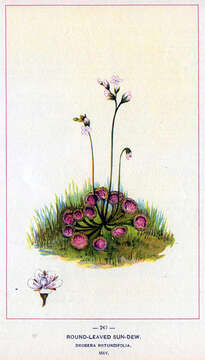Drosera rotundifolia chromolithograph

Description:
Description: Drosera rotundifolia chromolithograph print from the 1894 edition of "Wild Flowers of America" prepared by Botanical Fine Art Weekly (Published by G.H. Buek & Co., NY.). Date: 1894. Source: Scan of original. Author: Botanical Fine Art Weekly. Permission(Reusing this file): PD. Text on the chromolithograph reverse: "Plate 247. Round-leaved Sun-dew. Drosera rotundifolia. (Sun-dew Family.) Leaves all radical, rosulate, on long slender ciliate petioles, orbicular, the margin fringed with viscid, gland-tipped, reddish hairs; scape slender, bearing a slender, few-flowered, one-sided raceme, uncoiling as the flowers expand; petals white, five or six; stames five or six. Few plants excite more general interest and concern than those that live wholly or partly on animal food. Not to mention the Bacteria and many of the Fungi that live parasitically on animals and man, there are isolated groups among the higher plants that support themselves to some extent by entrapping and assimilating the bodies of insects. The Pitcher-plants or Side-saddle flowers, species of Sarracenia, are good examples. Of the same habit are the smaller and less known Sun-dews, cousins to the famous Dionaea, Venus' Fly-Trap. The species of Drosera are natives of sandy bogs, mostly in temperate regions. The margin of the leaf is fringed with red hairs, each tipped with a round gland. From this glad exudes a drop of viscid liquid, that glistens in the sunlight; hence the pretty name, "Sun-dew." This strange secretion has much the same solvent power as gastric juice. When an unwary gnat or other insect alights on the surface of the leaf, the marginal hairs, as if they saw a dinner before them, bend in toward the centre of the leaf, cover the unfortunate visitor with their sticky secretion, and so hold him prisoner until the tissues of the leaf have digested as much of him as they can. Then the hairs return to their normal position, awaiting another meal. Rotundifolia is the most common species of Drosera in North America. It flowers in late summer." Licensing[edit] Public domainPublic domainfalsefalse. : This work is in the public domain in its country of origin and other countries and areas where the copyright term is the author's life plus 70 years or fewer. You must also include a United States public domain tag to indicate why this work is in the public domain in the United States. Note that a few countries have copyright terms longer than 70 years: Mexico has 100 years, Jamaica has 95 years, Colombia has 80 years, and Guatemala and Samoa have 75 years. This image may not be in the public domain in these countries, which moreover do not implement the rule of the shorter term. Côte d'Ivoire has a general copyright term of 99 years and Honduras has 75 years, but they do implement the rule of the shorter term. Copyright may extend on works created by French who died for France in World War II (more information), Russians who served in the Eastern Front of World War II (known as the Great Patriotic War in Russia) and posthumously rehabilitated victims of Soviet repressions (more information). This file has been identified as being free of known restrictions under copyright law, including all related and neighboring rights.. https://creativecommons.org/publicdomain/mark/1.0/PDMCreative Commons Public Domain Mark 1.0falsefalse
Included On The Following Pages:
- Life (creatures)
- Cellular (cellular organisms)
- Eukaryota (eukaryotes)
- Archaeplastida (plants)
- Chloroplastida (green plants)
- Streptophyta
- Embryophytes
- Tracheophyta (ferns)
- Spermatophytes (seed plants)
- Angiosperms (Dicotyledons)
- Eudicots
- Superasterids
- Caryophyllales
- Droseraceae (sundew family)
- Drosera (Sundews)
- Drosera rotundifolia (Common Sundew)
This image is not featured in any collections.
Source Information
- license
- cc-publicdomain
- creator
- Botanical Fine Art Weekly
- source
- Scan of original
- original
- original media file
- visit source
- partner site
- Wikimedia Commons
- ID


